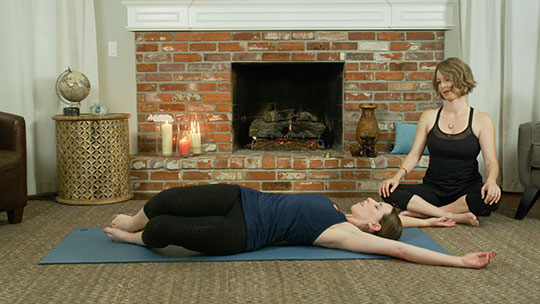
Thank you for joining Shannon and me for our chat about yoga and endometriosis. It was such a pleasure and an honor to be on the podcast!
Here are some resources that I mentioned on the podcast that you might be interested in.
Extension Progression
I put this progression together for my patients who have limitations with back extension or need to grade the amount of extension from day to day. This might be for a number of reasons, including back pain, bladder pain, or endometriosis.
The flow is designed to allow the individual to listen to their body and let their tissue response guide the progression into extension.
Tara Brach
I’ve had the pleasure of attending Tara’s workshops and she is an absolute delight. Here are some highlights for students interested in building a mindfulness practice:
- Meditation: Basic Body Scan and Breath Awareness (12:18 min.)
- FAQ for Meditation
- Meditating with RAIN (11:43 min.)
- My reflection on Wings of Presence
Breath cues
If you ask someone to contract and relax their upper traps, it’s pretty easy to do, especially with the visual feedback of a mirror. The pelvic floor muscles are a little trickier to connect with.
The Breath Cues Guide offers the idea of using bony landmarks to orient where the pelvic floor muscles are and what happens when you inhale or exhale. You may also be interested in this video demonstrating what happens with the pelvic floor during inhalation and exhalation
How does yoga help?
- Yoga mobilizes the muscles that attach to the thorax and pelvis.
- Yoga mobilizes the fascia that surrounds the uterus and the GI tract.
- Pranayama helps enhance the relationship between the breath and the pelvic floor (breath cues imagery and physiological relationship).
- Yoga re-balances the sympathetic nervous system override.
Research
Recent research on endometriosis reveals yoga reduces pain and improves quality of life.
A randomized control trial was performed in Brazil, looking at the use of hatha yoga to treat pain caused by endometriosis. The goal of the study was to evaluate chronic pelvic pain, menstrual patterns, and quality of life.
The study showed:
- Pain decreased in the group who practiced yoga.
- Quality of life improved, as documented by a participant questionnaire, was also statistically significant.
- Yoga is an effective practice in reducing the day-to-day chronic pelvic pain often experienced with endometriosis.
- Using yoga as an aspect of a holistic treatment plan for endometriosis is a tool that is safe, portable, and effective in improving quality of life.
Postures for women with endometriosis to try
In regards to Asana, we would want to think about spinal mobility, hip mobility, and anywhere else in the body that needs attention.
Pranayama can be useful, even paced breathing. Nadi shodhana can be very calming to the nervous system. Letting Go breath can also help reset the fight of flight system.
Other aspects of the Eight Limbs are of course always helpful for everyone:
- training mindfulness
- meditation
- the yamas
- niyamas
Ideally we want to create a yoga program specifically targeting the individual’s needs, but that isn’t always possible in a group class. Here are some ideas for postures in a group class and benefits associated with each pose:
Reclined Goddess Pose
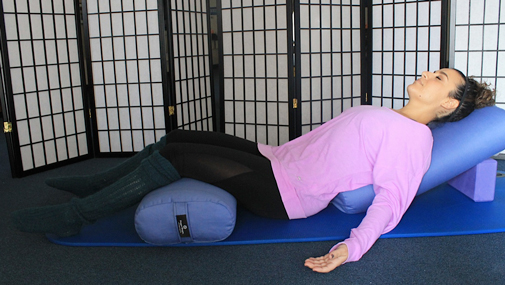
I love restorative yoga postures for a number of reasons, but especially because of the parasympathetic nervous system dominance. The sympathetic nervous system (fight or flight) gets stimulated with persistent pain, and activating the parasympathetic nervous system through a pose like the Reclined Goddess Pose can help reduce pain.
Child’s Pose
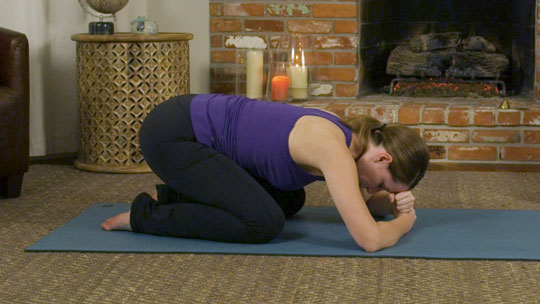
When people are flaring they will usually not want their abdomen to be on stretch. Child’s Pose is helpful for parasympathetic nervous system and stretching the back fascial lines while lengthening the front fascial lines.
Restorative Fish

Restorative fish is a nice option for stimulating the parasympathetic nervous system and lengthening the front fascial lines. This is nice during non-pain times (perhaps during the luteal phase) in case the stretch at the abdomen is too intense.
Banana
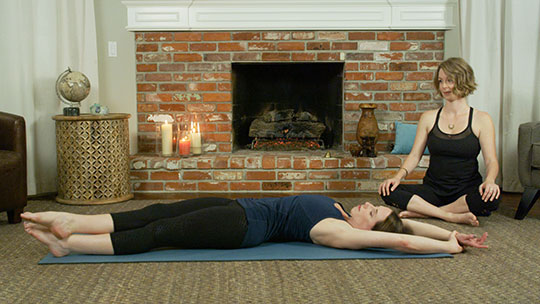
Banana is a supported side bend that allows the body to relax and soften into the stretch along the side body. This pose offers a myofascial release of the abdomen, increasing tissue excursion that has been decreased from adhesions or surgery.
Sidebending at the thoracolumbar junction (where the mid and low back meet and where the diaphragm inserts) offers space to breathe into the ribs on the elongated side. This is also a nice way to open the shoulder girdle.
Goddess with a twist
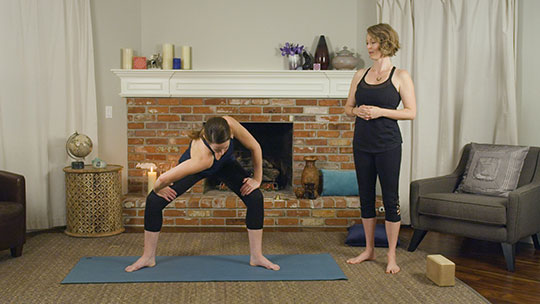
Goddess Pose also offers the opportunity to lengthen the muscles that attach to the pelvis and hip and builds strength in the lower extremity.
This posture increases tissue excursion in the abdomen that has been decreased from adhesions or after surgery. It also offers rotation at the thoracolumbar junction, lengthens the adductors, and builds strength in the lower extremities.
Happy Baby (modified)
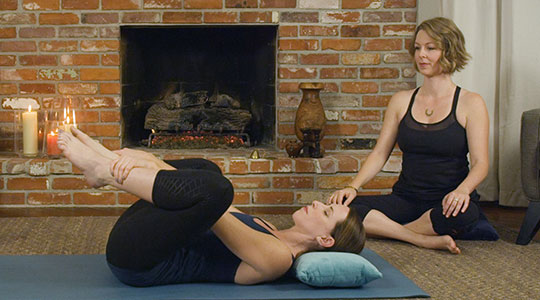
Modified Happy Baby pose increases flexibility of the posterior thighs and adductors, decompresses the lumbar spine and releases pelvic floor muscles.
The breath work calms the sympathetic nervous system is important for retraining the brain to rewire the pain response. Dampening the fight or flight response also helps with overactive bladder syndrome and urinary urgency.
Mountain
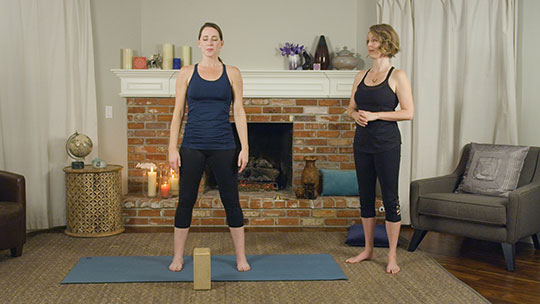
Mountain Pose allows for an embodied check-in for postural awareness. Playing with the weight distribution at the feet is a useful exercise in awareness and grounding.
Savasana
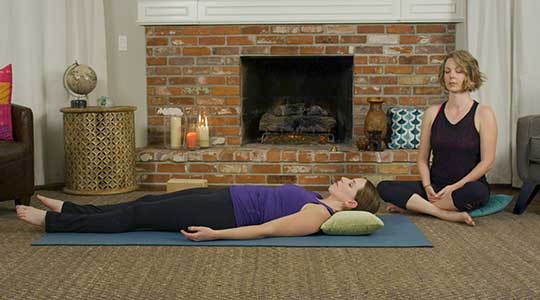
In Savasana, we experience a physical letting go of the body relaxing as the parasympathetic nervous system stimulates the rest and digest response. We experience a deeper mental space of being aware of what is going on around us while simultaneously being separate.
Sphinx and extension progression
Refer back to the extension progression.
Five Pointed Star
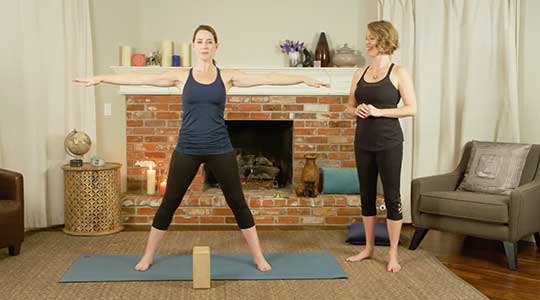
For women with endometriosis it is helpful to lengthen the adductors, hamstrings and other lower extremity muscle groups while building strength and grounding.
Supine Twist
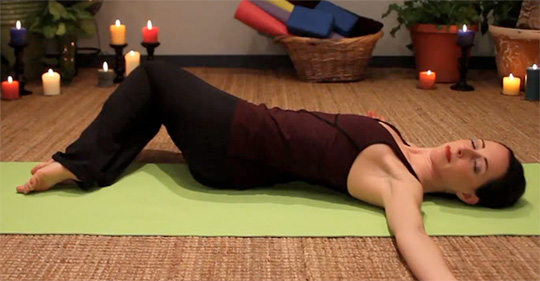
Supine Twist is a gentle twist that can be used alone or as a preparation for a deeper twist, such as revolved triangle pose.
Twist your knees to the left for the ascending colon and right for the descending colon to be mobilized via fascial connections. This is a nice myofascial release of the abdomen, especially when paired with the breath.
Warrior 2
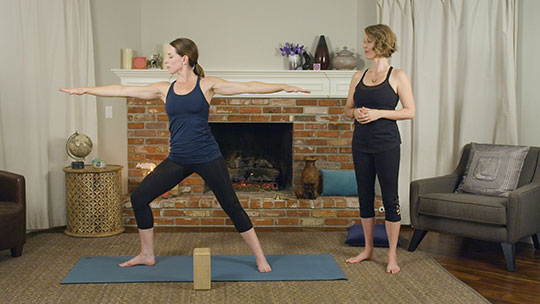
This popular posture strengthens the lower extremity, increases proprioception, improves balance, lengthens the inside of the back thigh and lengthens iliopsoas and fascia that connects to the lower abdomen.
More resources
- A beautifully written summary from a lecture on endometriosis from last year’s International Pelvic Pain Society’s Annual Meeting
- Endometriosis overview from U.S. National Library of Medicine
Let’s stay connected
If you have questions or want to bring me to your yoga studio for a workshop, I’d love to hear from you! Email me at info@yourpaceyoga or reach out on social.
